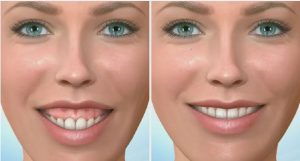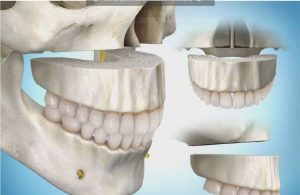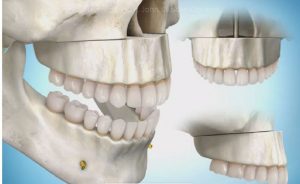Dental appearance is an important factor in determining the attractiveness of a face; thus, it influences human social interactions.The smile, in particular, plays a significant part in determining a first impression of an individual.Different factors contribute to the aesthetics of the smile.
An esthetic or pleasing smile maybe considered from 3 primary aspects.
(1) The teeth, including their general arrangement, position, colour , shape ,size.
(2) The lip framework.
(3) The amount of gum that shows, when one is smiling.
The topic of the current blog is (3) , “The amount of gum that shows, when one is smiling.”
Research suggests that a smile which displays all of the upper incisor crowns along with 1–2 mm of gingival (gum) margin is considered to be the most attractive. Usually, females tend to show 1–2 mm more of gingival tissue than males.
Excessive display of the gums during a smile, is referred to as “excessive gingival display”, the appearance maybe of concern to patients and to parents. Patients often present at Clonmel orthodontics seeking a solution to their gummy smile. Thorough examination which leads to the correct diagnosis is really important for achieving the best aesthetic outcome in these cases.
What causes a gummy smile?
A gummy smile or excessive gingival display,is caused primarily by three factors that determine how much gum tissue is visible, (1) the upper lip, ( 2) the teeth and supporting bone, and (3) The actual gums themselves maybe too far down the tooth. Often more than one of these factors alone can contribute to a gummy smile.
The upper lip maybe too short or too active
If the upper lip length when measured from the base of the nose to the lower border of the upper lip is too short , this may cause “excessive gingival display”. Sometimes the upper lip is of normal length but the patient lifts the lip excessively when smiling a so called hyperactive or hypertonic upper lip. The important thing to recognise here is that changing the vertical position of the teeth when the fault lies with the upper lip will not produce a satisfactory result. There are procedures available to adjust the length and activity of the upper lip, but these are very rarely availed of in Ireland.
The upper jaw maybe too long in a vertical dimension
If the lip length and behaviour is normal ,and the amount of gum covering the crown (top) of the teeth is normal, then the problem maybe with the actual position of the upper teeth. The vertical position of these teeth maybe too low down in the face due to the fact that the upper jaw has grown excessively in a vertical direction (vertical maxillary excess), or sometimes the teeth themselves have grown down excessively, or a combination of both. If this problem is mild and the upper teeth or upper jaw are only a little too long then fixed appliances (braces) with or without temporary anchorage devices (TADS) may achieve a satisfactory result by intruding the upper teeth and gingivae. However when the amount of excessive gingival display is more than 2-3mm , braces alone will not correct the problem completely. If the patient wishes to have the problem corrected(normally in the more extreme cases) then moving the whole jaw upwards surgically maybe considered.
The gums themselves maybe too far down the tooth (too long)
Sometimes if the lips are normal, and the position of the teeth in the vertical dimension is also normal, then the cause of the gummy smile maybe that the gums themselves are tooth long. This maybe due to
(1) Gingival hyperplasia; this occurs where there is an overgrowth of the gums around the teeth, this maybe caused by poor oral hygiene , or a side effect of certain medications , or less commonly certain genetic conditions.
or
(2) Due to the fact that the teeth have not erupted sufficiently (altered passive eruption).
When the cause of the gummy smile is either gingival hyperplasia or altered passive eruption of the teeth, this can be determined by checking the gums with a periodontal probe, this is a simple painfree procedure which your dentist may do routinely when you attend for a check up.
This simple test will tell if the gums are too long and resting too far down the tooth. If they are, the condition maybe improved by maintaining better oral hygiene or possibly by attending a gum specialist a (periodontist) who will remove the excess gum by performing a procedure called a gingivectomy.
Summary
I hope it is clear that there are many different causes for a gummy smile. The key is to have a thorough exam, so that the cause of the gummy smile can be accurately determine, before any treatment is commenced. In Clonmel orthodontics we are expert at evaluating the lips, teeth and jaws, gums, and how they all work together to create an attractive smile
…………………………………………………………………………………………………………………………………………………………….
(Clonmel Orthodontics blogs are intended to be factual rather than aspirational or for purely marketing purposes)
This orthodontic blog was written by Dr John Buckley,who is a specialist orthodontist at Clonmel Orthodontics in Clonmel County Tipperary, Ireland.He is both Clonmel’s most qualified and most experienced orthodontist.
Clonmel Orthodontics provides orthodontics to county Tipperary and the neighbouring counties of Waterford, Kilkenny, Limerick,Cork , and beyond.
Dr Buckley has practised as a specialist orthodontist in Clonmel for over 20 years. In addition to his orthodontic qualifications which he held before he commenced orthodontic practice , Dr Buckley was awarded a First class masters degree in Lingual orthodontics from the University of Hannover medical school (MHH) in 2012. This masters degree is directed by Professor Dirk Wiechmann who is the inventor of both the incognito™ and win™ lingual appliances. Dr Buckley was the first orthodontist in Ireland to be awarded this qualification. In 2016 he was accepted as an active member of the European Society Of Lingual Orthodontics (ESLO). To become an active member it is necessary for candidates to submit the records of finished lingual cases. If the cases are deemed to be of a sufficiently high standard then the candidate is accepted as an active member of ESLO. Dr Buckley is the first and only orthodontist in Ireland to be accepted as an active member of ESLO.






